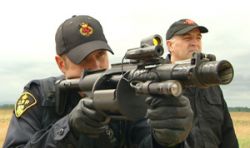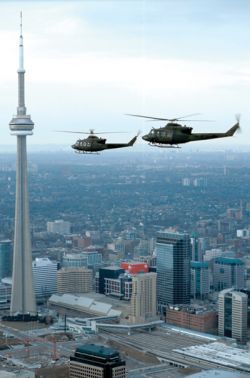Militarizing Police and Deploying Armed Forces: As elites and protesters converge, the state prepares for war
BLOG POST posted on June 21, 2010 by acrosby
The ARWEN: violence and language surrounding “less-lethal” weapons
In another bid to intimidate protestors and show off yet another garment in the G8/G20 security "fashion show of repression", a portion of the daily summit scaremongering from mainstream media was dedicated to reporting on the unveiling of the latest police crowd-control weapon. The ARWEN 37 (Anti-Riot Weapon ENfield firing 37 mm rounds) is a “less-lethal” weapon loaded with rubber bullets and tear gas. It joins the LRAD (Long-Range Acoustic Device) sound cannon and other now well-known munitions (stun grenades, tasers, pepper spray, police dogs, and batons) as part of the police arsenal comprising a $1 billion security apparatus for the G8/G20 summits in June 2010. The ARWEN was first designed by the British military in 1977 as a multi-shot riot control weapon, to be used by British police in Northern Ireland. However, former riot cop James Cassells, who now works for Police Ordnance, the Canadian manufacturer of the weapon, explained to the CBC that the weapon was never deployed in Belfast because it looked too menacing (although there are reports of at least one ARWEN-related fatality in 1984). The unwelcoming appearance of this “less-lethal” styled grenade launcher, however, is not deterring the G8/G20 Integrated Security Unit (ISU) to arm its units in the streets of Toronto. What you should know about the ARWEN 37:
- Can fire 5 rounds in 4 seconds without reloading
- Munitions are easily interchangeable (bullets/tear gas)
- Bullets travel at rate of 74 metres/second
- Can be fired from 100 metres with claims of high accuracy
- Being shot likened to being hit by baseball thrown by major league pitcher
- G8/G20 ISU have obtained dozens in the lead up to the summits
Police have expressed that the use of the weapon outside of the G20 summit will “depend on protestors” and its main function will be “to restore order”. However, there is increasing concern from civil society groups about the deployment of “less-lethal” munitions against unarmed protestors. Labour leaders are seeking a court injunction preventing police from using the LRAD during the summits citing that the use of the device as a weapon to disperse crowds can cause permanent hearing damage.
Natalie Des Rosiers of the Canadian Civil Liberties Association expressed that, “Our laws require that new weapons be tested and approved by the Solicitor General before they are used on the public.” With a court hearing over the use of the LRAD scheduled for Wednesday, two days before the summit in Toronto, it is unlikely that civil liberties advocates will have enough time to mount a legal opposition against the use of the ARWEN against crowds congregating outside the 8-foot high security fence.
This should be extremely alarming to the Canadian public as Brian Kirkey, President of Police Ordnance, expressed the severity and potential for injury and death as a result of being shot with the ARWEN: “It'll break bones if it hits. You don't want to hit them in the head. You don't want to hit them in the neck. That's where you have a potential fatality.”
The ARWEN represents yet another weapon that intimidates and violates the right of the general public to exercise democratic dissent. However, police continue to employ jargon in an effort to legitimize the use of weapons developed by military forces to be used against civilians in the streets of Canadian cities. When speaking about the possible damage inflicted by ARWEN ammunition on the human body, Ontario Provincial Police Constable Mel Tourigny expressed that, “It's realistic to accept that there very possibly could be an injury to a person being struck by this projectile, but it's a less serious injury because it's deemed a non-lethal [weapon].”
The Canadian Forces: The normalization of domestic deployment alongside police
While troubling, the trajectory of police militarization over the years raises another important question as to why the Canadian Forces are increasingly being deployed alongside law enforcement within a domestic policing context. In recent years, there has been an increasing focus on amalgamating security units (police/military/private security) around large ministerial summits and sporting events.
During the Olympics in Vancouver, the Vancouver Integrated Security Unit (VISU) comprised a $900 million budget and over 16,000 security personnel, including 4,500 members of the Canadian Forces. The G8/G20 summits in Huntsville/Toronto are following the same trajectory, except on a larger scale and in a shorter time frame. The G8/G20 Summits Integrated Security Unit (ISU) is led by the RCMP and comprised of partners from the Canadian Forces, Ontario Provincial Police (OPP), Toronto Police Service (TPS), and Peel Regional Police (PRP). Canadian Forces Operation CADENCE 2010 will provide support to the ISU for the duration of both summits, while the elite special forces unit JTF 2 will remain on standby. The visibility of the CF as part of the ISU remains ambiguous according to the ISU website: “The visibility of Canadian Forces members involved with the G8 and G20 summits will range from very low to highly visible, depending on their location and the tasks to be performed.”
Canadian Forces G8/G20 Summit ISU Roles and Responsibilities:
- Support the ISU
- Supplement existing federal, provincial, and municipal law enforcement resources and assets
- Provide land and air surveillance, underwater safety and security for the venues
- Assist with logistic and ceremonial aspects of the Summits
- Provide unique military resources and capabilities provided by the army, navy, and air force
Let's break down the last point a little further:
The army:
- will maintain observation posts and surveillance, while conducting joint patrols of the Toronto Pearson airport and the Huntsville area
- Soldiers from across Ontario have already begun to move into the G8/G20 summit areas, comprising the largest deployment of Reserve soldiers in a planned operation in history
The navy:
- will support the RCMP’s maritime security operations, including providing port security and dive teams
The air force:
- will conduct surveillance missions, early warning detection, and the air lift of people and equipment in conjunction with regular NORAD duties
Although the military has stated that it will not be involved in policing functions such as crowd control, the increased presence of armed forces in Canadian cities is cause for concern. The military mission falls under Joint Task Force Central, one of six regional task forces reporting to Canada Command which was established in 2006 and coordinates the domestic operations of the Canadian military.
The Future of Democracy and Dissent
The increased militarization of local and national police forces, along with the normalization of military units working alongside law enforcement agencies in a domestic context, signals a decreasing legitimacy on the part of the state. Efforts to stifle democratic dissent in public spaces outside large ministerial summits, in which a few elites generate a policy apparatus governing the global economy in an explicit undemocratic fashion, are being met with increasing opposition. On the other hand, Canadian military and police forces, holding a monopoly on the use of coercive force (violence), that continue to deploy with billion dollar budgets to protect elites making decisions in the interests of capital and profit, also lends increasing legitimacy to a mass democratic movement dedicated to opposing this apparatus of injustice. Tens of thousands of people, willing to put their bodies on the line in the face of violent repression, are sending a clear message to the state, that passion and a yearning for justice will win out in the end against a short-sighted quest for profits.
The site for the Vancouver local of The Media Co-op has been archived and will no longer be updated. Please visit the main Media Co-op website to learn more about the organization.


Comments
Increased repression indicative of elite fragility
THanks for the analysis Crustby, and I agree with you especially towards the end where you identify that "tens of thousands of people, willing to put their bodies on the line in the face of violent repression are sending a clear message to the state: passion and a yearning for justice will win out in the end against a short-sighted quest for profit.
I think the intensifying of state repression and tactics to remove public dissent from the closed door meetings of elites that hail from teh same social circles, same schools, and represent the same interests around the world, is indicative of how fragile elite interests are becoming.
arwen
the Arwen was used extensively in northern ireland through the 1970s and 1980s, with many people being killed, maimed, and wounded. many of these were children, and injuries included loss of eyes, fractured bones, etc. the assertion that the Arwen wasn't used because it was too scary looking is bullshit.
the first Arwen's shot only one round and were broken open like an old style double-barreled shotgun. Arwen's are also referred to as Multi-launchers and now have cylindrical magazines that hold up to six rounds that can fire a variety of munitions including baton rounds, tear gas, pepper spray, rubber balls or pellets, bean-bag rounds, etc.
it is recommended to wear some form of protective clothing and equipment. padded body armour can be improvised from sleeping mat foam cut out and secure around the torso. Shin pads, knee pads, elbow pads etc, can be worn on arms and legs.
and oh ya, fuck the pig police and their tear gas
Water Cannons
Thanks for the clarification regarding the ARWEN's use in N. Ireland. I think it would also be useful to post an extensive list of counter-measures elaborating on how people can protect themselves from a variety of weapons that they may never have faced before.
Another example, police announced yesterday that they would be adding water cannons (water projectile systems) to their arsenal to "wash away a riot". RCMP have an undisclosed amount of WPSs and will deploy them beginning on Friday in both Huntsville and Toronto.
This all in a report from the Toronto Sun that police have uncovered caches of "protest weapons" around the city, hidden concrete blocks and the like....
Concrete Blocks
Last time I checked, concrete blocks were used to build houses, and are a bit heavy for protesters to throw. This security is all getting a bit far stretched and heavyhanded.
Police harassing locals far in advance of summit
and far away from the fence. I heard testimonials of residents being harassed in parks that were supposed sites of caches of "protest weapons", as was mentioned above, construction materials and waste. These testimonials speaking to police being scared in the run up to and during the summit. However, some fears were completely unfounded as police had even accused park-goers of pre-emptively stashing syringes in which to attack police horses..... anyone know where they come up with this stuff?